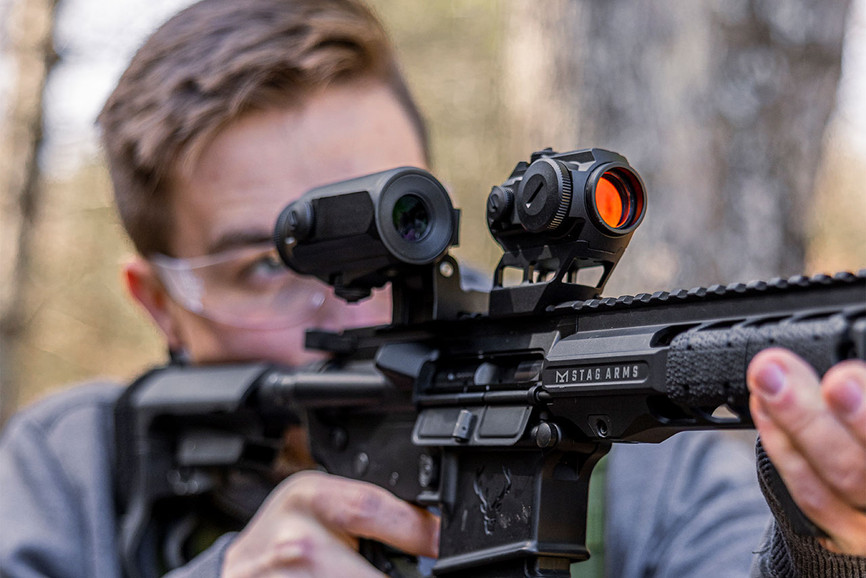
Why Buy a Red Dot Sight? Complete Guide (2025)
Posted by Monstrum on Nov 10th 2025
Whether you’re setting a rifle up for competitive shooting or home defense, one of the most important decisions you’ll have to make is what optic to buy. One of the key considerations of choosing an optic is how quickly it will allow you to put shots on target
With training, iron sights can be fairly quick, but you have to line up two components (front and rear sight) against your target before you can take a shot. Scopes and prism sights can be fast too, especially if you’ve practiced a consistent cheek weld and are familiar with the eye relief on your setup, but both of these optics types have eye boxes. That means if your eye is outside of a very specific position, you won’t have a usable sight picture for an accurate shot. If you want an optic that allows you to put shots on target as fast as possible, one of your best options is a red dot sight.
What is a Red Dot Sight?
Red dot sights are electronic 1x optics designed for fast shooting at close range. They work by using the light from an LED emitter reflected off the back of the front lens as a reticle to aim.
Red dot sights got their name because originally, their reticle was a simple red dot, though today, red dots are offered in multiple reticle and color options. Red dot sights have no magnification, but they can be paired with magnifiers for added range, and they have unlimited eye relief with very generous eye boxes. Like other optics, they are windage and elevation adjustable, but they are also adjustable for brightness, a key setting for aiming passively through night vision devices or for shooting into or out from bright or dark environments.
Because red dot sights rely solely on an electronic emitter to function, they are not usable without a working battery, although these days, quality red dot sights have battery lives measured in tens of thousands of hours of runtime. When paired with battery-saving features like automatic shutoff, a modern red dot sight can remain functional for practically indefinite periods of time depending on use and storage conditions, though prudent red dot sight owners change the batteries on a set schedule biannually and always carry replacement batteries.
Because they have unlimited eye relief and extremely generous eye boxes, red dot sights are among the fastest optics to use in most practical applications. The key to their generous eye boxes is the fact that there are neither magnifying lenses nor an etched reticle on a separate focal plane inside the body of a red dot sight, just a simple dot reflected off a piece of glass.
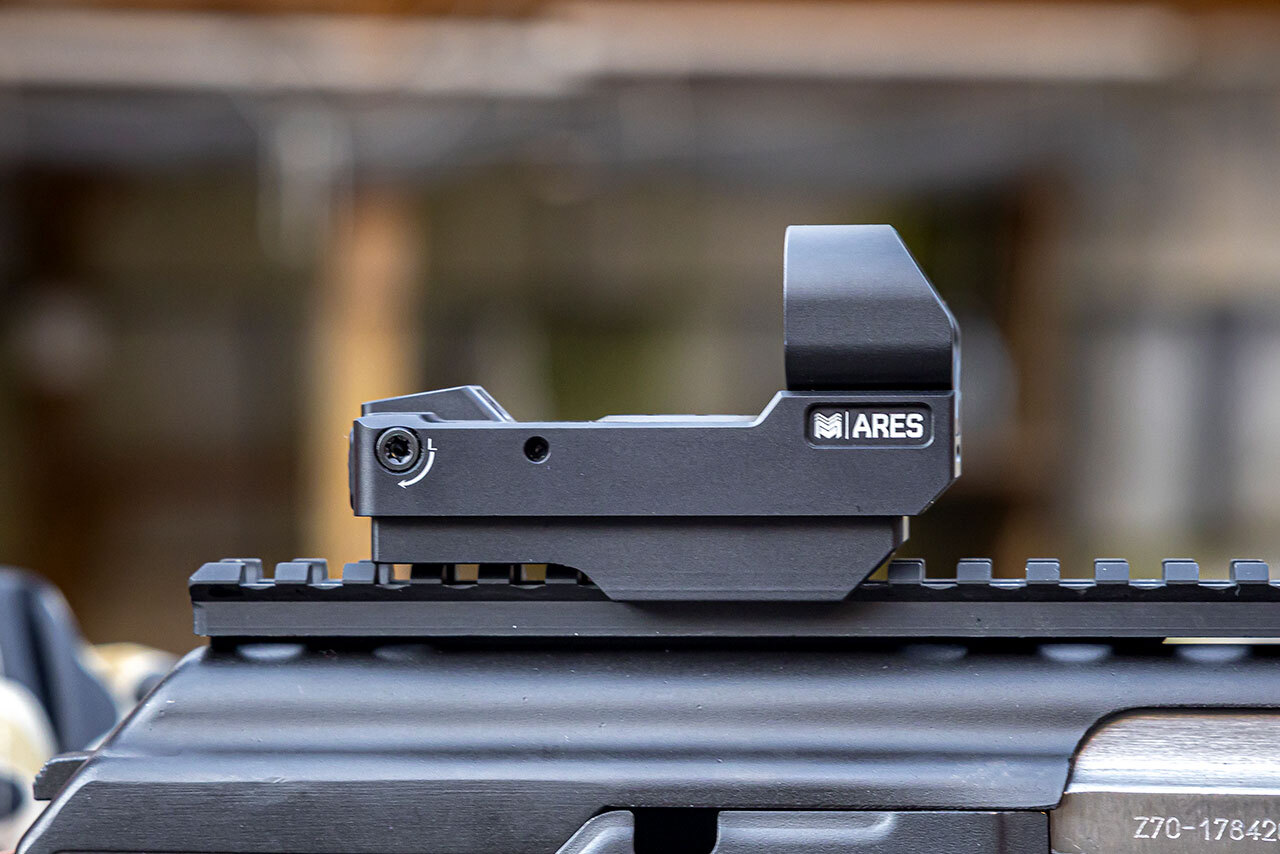
Types of Red Dot Sights
There are two types of red dot sights: Closed-emitter with two lenses and a sealed housing, or open emitter with just a single front lens. Red dot sights were originally all closed-emitter with open-emitter designs coming later. The key differences between the two types are profile and susceptibility to dirt or debris. Open-emitter sights can become blocked by debris blocking the emitter whereas closed-emitter sights cannot.
Red dot sights also come in several sizes with multiple options for mounting, but they tend to fall into one of two main categories based on the type of firearm they were designed to be used with: long guns and handguns respectively. Long gun red dot sights have larger bodies and finer adjustments for precise shooting with magnifiers whereas pistol red dot sights are much smaller with coarse adjustments and sometimes larger reticles.
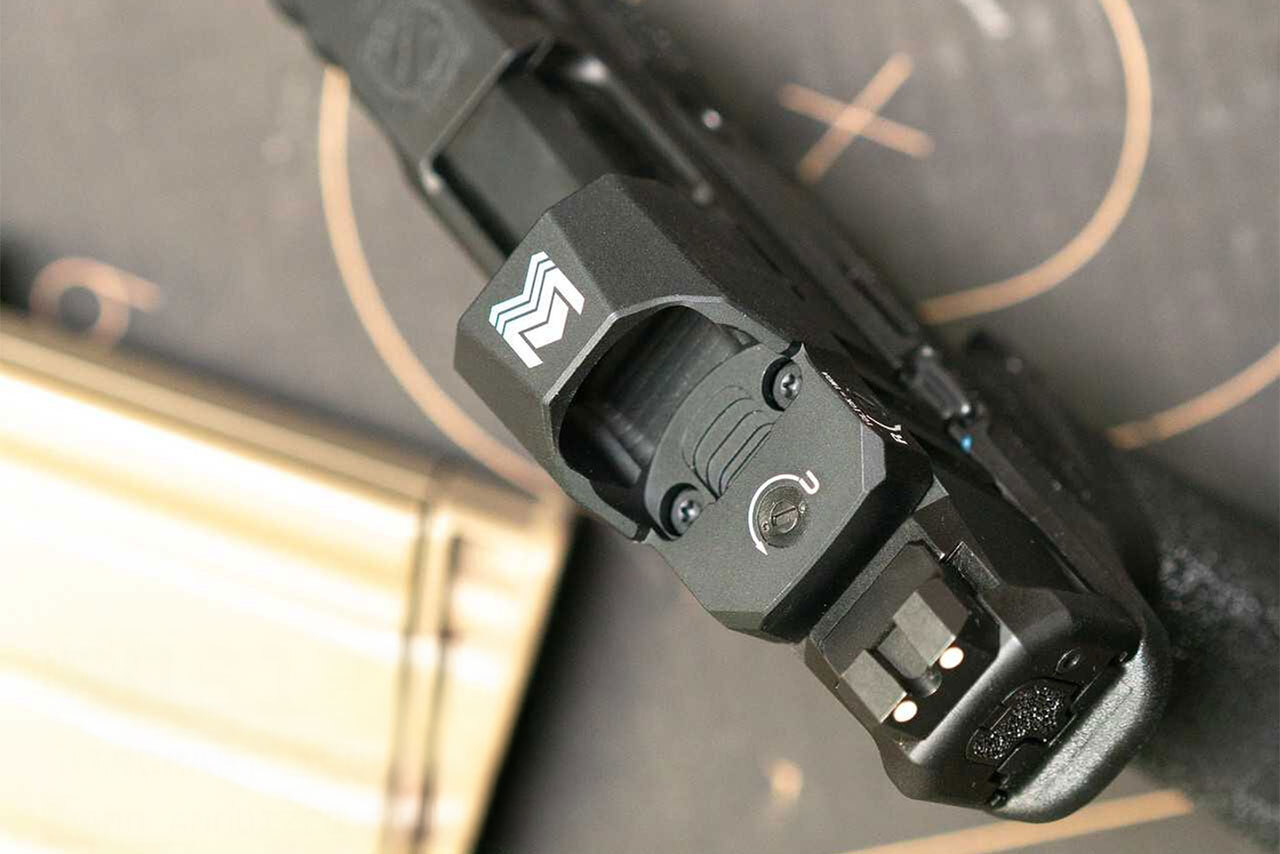
Red Dot Design History
The first red dot sight was the Aimpoint Electronic® which was invented in 1975. Early red dots were large and designed to mount to rifles via traditional scope mounts, but as the technology improved, they became smaller and lighter. Battery life grew by leaps and bounds and so too did advancements in reticle brightness and glass coatings. Early red dot sights were plagued by a prominent blue tint to help contrast the comparatively weaker emitters of their day.
Open emitter designs came later and they were originally made for the competitive shooting market with a less occluded sight picture, but this came at the cost of being vulnerable to dirt and debris obstructing the emitter.
Pistol red dot sights have been around almost as long as their rifle-mounted counterparts. At first, they were just slightly smaller rifle red dot sights and could only be mounted to large handguns that had optics mounting points for long eye-relief scopes, but these early designs evolved to become both smaller and lighter.
The first modern pistol red dot sight to see widespread use was the Trijicon RMR®. When it first came out, it was a revolutionary design made durable enough to mount directly to a pistol’s modified slide or it could also mount to any picatinny rail with an adapter.
During the Global War on Terror, pistol red dot sights were adapted for back-up sighting use on rifles as so-called “piggy-back” optics—these were usually a Trijicon RMR mounted atop a Trijicon ACOG or other magnified optic so a shooter could quickly transition from a magnified sight picture to the unmagnified red dot if engagement distances changed.
Today, there are more options for red dot sights than ever before. Modern red dot sights are small and extremely durable with plenty of mounting of options for both handguns and rifles.
Red Dot Sights and Magnifiers
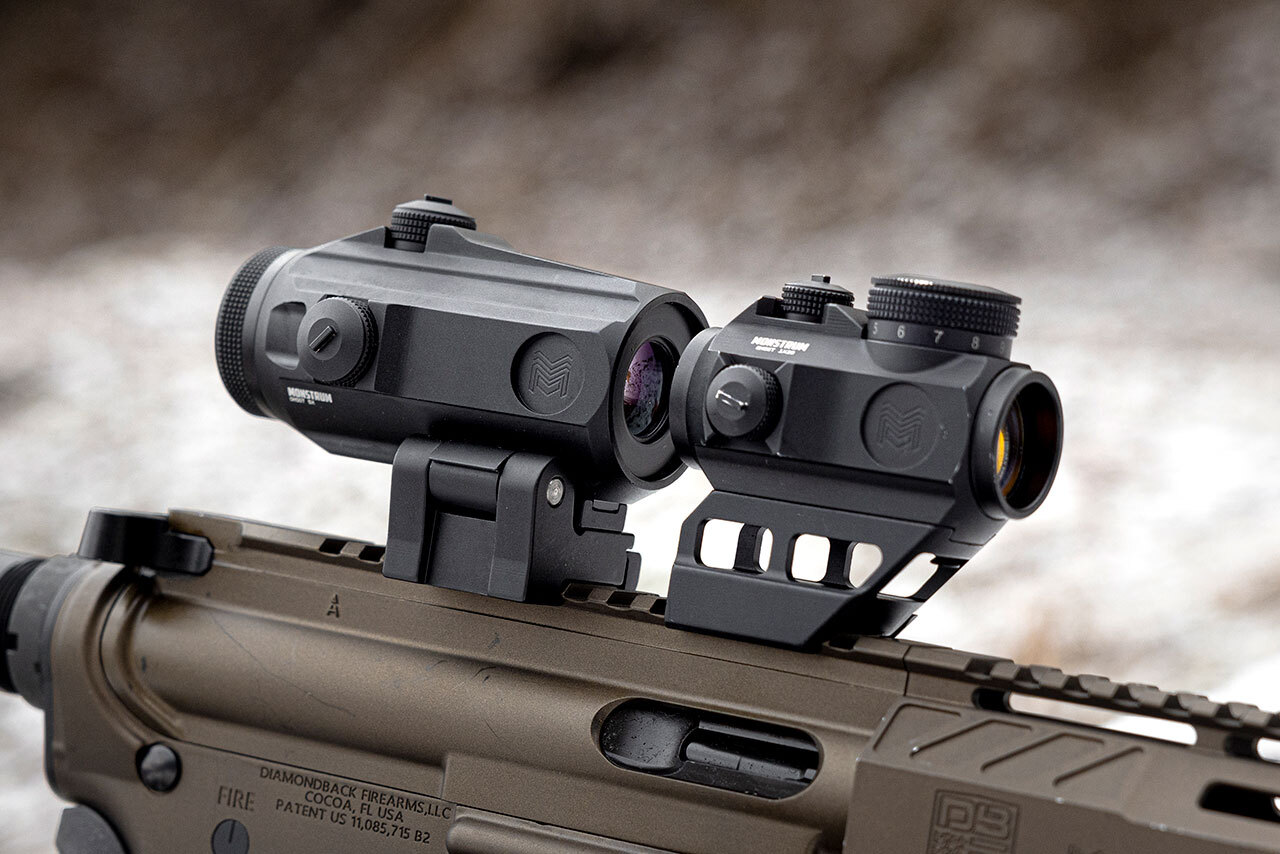
Red dot sights key limitation as rifle optics is their lack of magnification. Because they are only 1x, they are often paired with a magnifier, a separate optic that merely magnifies the sight picture of another optic, to extend their effective range.
Magnifiers are typically mounted to flip-to-side bases so they can be flipped in or out of place on the fly. While they can extend the range of a red dot sight, they have a couple of drawbacks. First off, magnifiers have an eye box, while it’s usually a pretty generous one, this negates one of the major advantages of red dot sights—speed. Second, magnifiers have to be “zeroed” (mechanically centered to the sight picture of their counterpart optic) and they tend to shift out of alignment gradually under normal use, though red dot sights with magnifiers are still usable even with an offset alignment, this issue can prove annoying to those with OCD. Finally, magnifiers add weight (magnifying lenses being the heaviest part of any optic) and they occlude part of a shooter’s peripheral vision when not in-use. While the latter may not seem like much of an issue, bear in mind that red dot sights are typically mounted as far forward as possible specifically to preserve the shooter’s peripheral vision. Occlusion can be a major pain point when switching from one target to another or simply maintaining situational awareness. This issue can be alleviated with flip-to-center mounts, but these have the trade-off of occluding part of the red dot’s sight picture when not in use instead.
Magnifiers come in two types: rear-mounted and forward-mounted. Rear-mounted magnifiers magnify both the target and the reticle of the red dot sight they are mounted behind. This means that a 2 MOA red dot will look like 4 MOA under 2x magnification, but the target will also be magnified proportionally. A larger reticle can be an issue for taking precise shots because it can occlude or bloom out parts of your target, but this issue is effectively solved by forward mounted magnifiers.
Like the name suggests, forward-mounted magnifiers sit in front of their counterpart optics magnifying only the target and not the reticle. This is a major advantage because your reticle remains small while your target gets larger making accurate shot placement easier. Check out our recently launched Ghost 2x Forward Mount Magnifier to see these work in practice.
While red dot sights are not ideally suited for medium to long range shooting, magnifiers can be a great way to round out the capability of your rifle. With training, the drawbacks of a red dot + magnifier combo can easily be overcome and for the cost of a bit more weight, a rifle with this setup can effectively cover long to medium range shooting with ease.
Advantages of Red Dot Sights
Red dot sights are the gold standard optic for close quarters shooting. They excel at this because of their unlimited eye relief and simple bright reticle that is very easy to pick up and use with both eyes open. Well designed red dot sights are also nearly parallax free meaning you can still take accurate shots even with an imperfect sight picture say after hastily shouldering your rifle from an awkward position—if you see the dot, even along the outside edge of the optic, and the dot is on your target, you’ll hit your mark.
Red dot sights are also one of the two best options for aiming passively with night vision devices (the other being holographic sights). The electronic emitters they use to project their reticles can be precisely tuned to put out just enough light for crisp, usable reticle when seen through the image-intensified view of a night vision device. They are also aided by the fact that they have no magnification and no eye box giving them a forgiving area through which a night-vision equipped shooter can acquire a sight picture. If you’re considering buying a red dot sight for use with night vision, be sure to check that the model you’re considering has night vision settings and consider getting a taller riser to make it easier to shoot while wearing NODs.
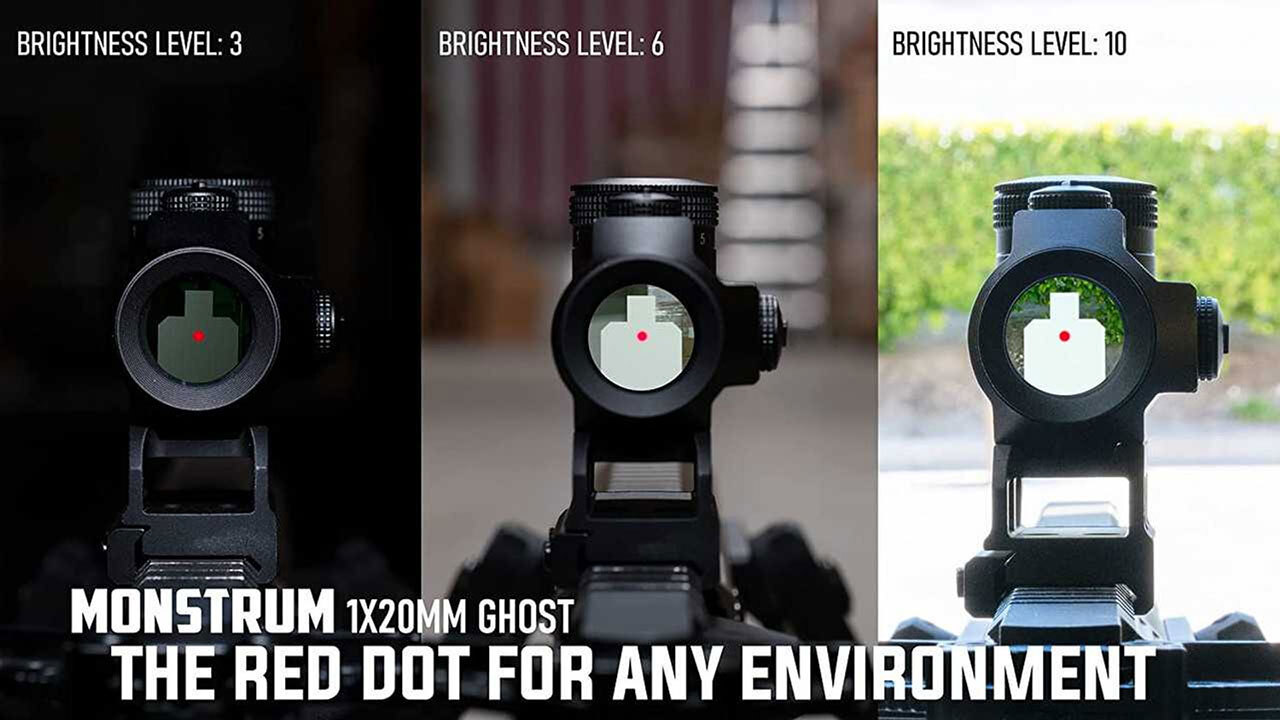
Disadvantages of Red Dot Sights
Red dot sights struggle at medium and longer ranges for the same reasons as iron sights: the unaided human eye struggles to focus on objects at range. Because red dot sights have no magnification to speak of, they can be difficult to hit distant targets with. This shortcoming is largely resolved by pairing with a good magnifier, although this setup doesn’t offer the same degree of precision that an etched reticle can provide.
Being battery-dependent to work, shooters who choose to run red dot sights should always carry spare batteries and keep track of when they should be changing old batteries out (as mentioned before, most swap batteries every other year).
Astigmatism and Red Dot Sights
Shooters who have astigmatism in their dominant eye may also struggle to use red dot sights because to their uncorrected eye, the reticle will look like a blurry star or smear instead of a crisp dot. This issue is typically resolved by wearing corrective lenses (either glasses or contacts work), but even with correction the dot may not look crisp.
This phenomenon is due to the fact that astigmatic eyes do not focus incoming light cleanly onto a single point the back of the retina due to the cornea, lens, or both being misshapen (if you have astigmatism, you’ll also notice car headlights or street lamps at night have the same effect). One easy way to test how affected your sight picture might be is to take a picture on your phone of your red dot sight’s reticle and compare it to your own vision.
While shooters who have astigmatism may struggle to see a clean crisp dot through red dot sights, bear in mind that corrective lenses and the distances you would use these optics negate the severity of this issue, but shooters with severe cases of astigmatism might be better served by a 1x prism sight which can be nearly as fast as a red dot, but uses an etched reticle instead.

Red Dot Sights vs. Holographic Sights
We mentioned already how red dot sights are different from telescopic and prism scopes in that they have no magnifying lenses, no eye box, and that their reticles are entirely electronic, but there is another optic type that has similar characteristics and close range performance to red dots with a few differences: holographic sights.
Like red dot sights, holographic sights are 1x optics with no magnification and an electronically powered reticle that will not function without battery power, but where holographic sights differ from red dots is the means by which they project their reticles. Holographic sights use a laser, instead of an LED emitter, which is passed through a holographic plate to project a holographic image of a reticle through the lens.
In practical application, the end result of both optics are similar, shooters will see a brightness adjustable red (or sometimes green) reticle through which they can aim, but the technology of holographic sights offers two advantages over the comparatively simpler tech of red dots. First, holographic sights have the potential to be much more durable than red dot sights because they do not rely on the front lens to function. This means that even if the front lens were to crack or break, the optic could still be usable where a red dot would not, assuming the electronics were undamaged. Second, holographic sights work better with magnifiers than red dots because the center dot of a holographic sight’s reticle does not grow larger with magnification as it does with red dot sights. This is because with holographic sights, the center dot of the reticle is an infinitely precise point of light that the human eye resolves as being roughly 1 MOA. That means no matter how much magnification is applied, the dot at the center of a holographic sight reticle does not increase in size whereas a red dot sight’s reticle has a definite size that increases in size proportionally with magnification. For many years, holographic sights were touted as being the superior optic choice for passive aiming with night vision devices, but these days good red dot sights offer nearly indistinguishable night vision performance from holographic sights.
For all the advantages that holographic sights have over red dot sights, they also have two significant drawbacks. First, holographic sights have significantly shorter battery life than red dot sights. For comparison, an EO Tech EXPS3® is advertised as having a 1,000 hour runtime on setting 12 out of 30 whereas our Ghost Gen 3 Red Dot Sight can run for up to 50,000 hours. Holographic sights must be deliberately turned off after each use and users must be prepared to keep track of battery life much more closely than red dot sight users. The second disadvantage to holographic sights is their cost. The least expensive EO Tech is the HWS 512® which retails for $545 on their website whereas our closed-emitter red dot sights start at just $79.95. This price difference mainly comes down to the more complex technology that holographic sights use to project their reticles.
While holographic sights can offer some advantages over red dot sights, for most shooters in practical application, these differences do not justify the significant price increase over red dot sights. On top of that, the significantly shorter battery life of holographic sights further reinforces red dot sights as the more practical and better value choice for 1x optics.
Conclusion
Why should you buy a red dot sight? Because they are some of the fastest optics to use and, when paired with a good magnifier, they can become extremely well-rounded with few drawbacks for most practical shooting applications.
Because red dots have no magnification, unlimited eye relief, and generous eye boxes, shooters can also acquire a usable sight picture with them at speed even without perfect technique—this is the main reason why they are so effective for dynamic close-quarters shooting. While some shooters prefer to use holographic sights in lieu of red dot sights, the far shorter battery life and significantly higher cost outweighs their technological advantages for the vast majority of civilian shooters.
If you’re looking for a quality affordable red dot sight to complete your next build, check out our full line of red dot sights and magnifiers.

